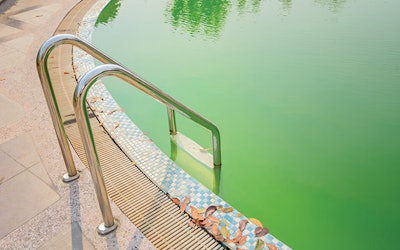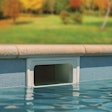
Of all the pesky water chemistry issues you’ll encounter when servicing pools, algae may be the most common. Algae, a nonflowering plant, commonly strikes when sanitizer levels are low, though it can also arise as a result of poor circulation and filtration. Events that create high chlorine demand, like pool parties and rain storms, can also lead to algae blooms.
Below, we go through the basics of algae and share how you can bring a pool from green (or black, yellow or even pink) to clean.
What Is Algae?
“Algae” in swimming pools are single-celled plants (algae) or filamentous bacteria (black algae). Pool algae is all photosynthetic, but some types are able to live in the dark inside the plumbing system and use organic matter as their food source.
RELATED: Tips and Tricks for Tough Algae
While it is a nuisance, if the pool is adequately sanitized (1-4 ppm free chlorine), the presence of algae does not necessarily indicate a human health risk. However, because some algae can multiply rapidly and obscure visibility, it can present a safety risk to swimmers. When this occurs, the pool must be closed and the clarity of the water restored before swimmers are permitted to re-enter the pool.
Types And Treatment
Treating algae begins by identifying the type of algae present in the pool. Pool professionals typically use an informal classification system based on its appearance, particularly color. Algae is classified as green, mustard and black:
GREEN
Green algae is common and varies from a pale to dark green. When this algae is not controlled, it turns the water green and can reduce visibility to near zero, potentially creating slippery and unsafe conditions. These outbreaks can happen overnight when the chlorine drops below 1 ppm. The most common green algae belong in the genus Chlorella.
Green algae is easily managed. Even severe outbreaks with pea-green water and zero visibility are often controlled by a single shock treatment of 5-10 ppm free chlorine. If green algae is a recurring problem, it is likely that the free chlorine levels are below 1 ppm or the biguanide system is not being adequately maintained. Improvement in disinfection maintenance coupled with weekly use of a quaternary ammonium-based algaecide are usually adequate to prevent further outbreaks.
MUSTARD/YELLOW
Mustard or yellow algae varies in color from gray to dark green to mustard yellow. Regardless of its color, this algae typically grows on the pool floor, walls and in undisturbed spots that lack proper circulation. When brushed, this algae resembles clumps of dirt and can easily cloud the water; after some time, the algae will re-settle on the pool floor.
In late stages of outbreaks, mustard algae forms large circular spots up to several feet in diameter on the pool floor and walls. Mustard algae frequently causes repeated outbreaks. There are several different species of mustard algae, the most common of which is Eustigmatos vischeri.
Mustard algae, because of its physical structure, is highly resistant to normal chlorine levels (1-4 ppm). Shock chlorine treatments of more than 5 ppm coupled with a metal-based algaecide are generally the most effective treatment, especially when repeated three to five days after the initial application. Dual halogen- and ammonium-based treatment systems are also effective in treating mustard algae.
In biguanide-treated pools, mustard algae is treated by using a polyquat-based algaecide and hydrogen peroxide as an oxidizer.
RELATED: Bromine Chemistry for Spas and Pools
Mustard algae can be persistent and often requires repeated treatments once an outbreak starts. There are several reasons why that happens. First, the most common type of mustard algae has an outer shell that protects the four spores in the shell. Since it commonly sits on the pool floor, it does not get exposed to most of the treatment chemicals in the body of water. Therefore, brushing the pool BEFORE administering treatment increases the exposure of the cells to the treatment chemicals.
In addition, because mustard algae also hides inside light fixtures, behind the ladder and inside the filter, there are spots that do not get disturbed during treatment. Thorough brushing is essential with mustard algae. Backwashing the filter before treatment and chemically cleaning it afterward also improves treatment effectiveness.
BLACK
Black algae, previously referred to as blue/green algae, is the least common type of algae you’ll see in pools. Black algae forms small, often irregular dark patches that are difficult to brush loose. This is because the algae has really long filaments that send root-like shoots into the pool surface. The most common type of black algae is the filamentous bacteria Phormidium.
Black algae is best controlled by thorough brushing and a spot application of granulated chlorine. A spot application increases the local chemical concentration and thus penetrates deep into the attached root of the algae. Most of the treatments for black algae are granular products.
RED/PINK
Red or pink algae is a term often used to describe red slime-like growth in both chlorine- and biguanide-treated pools. Red algae is not algae. In chlorine-treated pools, the slime is produced by bacteria. The red color is the pigment from the photosynthetic bacteria, usually Rhodobacter, but other species have also been reported. This is the same bacteria that causes pink rings in rarely used toilets and shower curtains. In biguanide- treated pools, the pink color is from the fungus Paecilomyces lilacinus, which is also called water mold, pink mold and pink slime.
Precautions
RELATED: The Science of Starving Algae
Always follow all manufacturer’s label directions on how to apply products, including the appropriate personal protective equipment. Because nearly all algaecidal treatments raise the chemical concentration in the water, pay particular attention to label directions on when it is safe to re-enter the water. Close pools until acceptable clarity is reestablished.
References
George P. FitzGerald and Daniel F. Jackson. 1979. Comparative Algicide Evaluations using Laboratory and Field Algae. Aquat. Plant Manage. 17:66-71
Milton R. Sommerfeld and Richard P. Adamson. 1980. Laboratory Comparison of the Effectiveness of Several Algicides on Isolated Swimming Pool Algae. AEM, 39(2) 348-353.











































